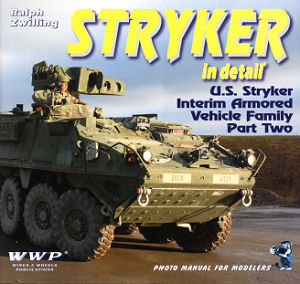 Stryker
in
detail
Stryker
in
detailU.S. Stryker Interim Armored Vehicle Family
Part Two
Present Vehicle Line No.19
Ralph Zwilling
Wings & Wheels Publications.
Published by RAK, Czech Republic.
ISBN 978-80-86416-68-7
191 pages all in colour.
Review by Terry Ashley
This is the second volume from Wings & Wheels Publications on the M1126 Stryker ICV and follows Part One in dealing with some of the specialized versions of the Stryker family, in particular the M1129 MC (Mortar Carrier), M1131 FSV(Fire Support Vehicle), M1133 MEV (Medical Evacuation Vehicle), M1134 ATGM (Anti-Tank Guided Missile Vehicle) and M1135 NBCRV (NBC Reconnaissance Vehicle).
The 191 page book has the usual card cover as well as a glossy paper dust jacket with a different image than the inner cover with full English text and extensive photo coverage of the featured variants with a little more text than usual starting with a 12 page summery and description of the Stryker family and the variants featured in the book with the remaining text confined to the photo captions and a brief introduction with each chapter.
M1129 Stryker Mortar Carrier Version A & B Pages 13-45
This chapter begins with 6 pages of half text and photos for a more detailed description on the Mortar Carrier Version and this is followed by an exterior walk around that has close-up shots of the rear hull arrangements which are the main external differences from the standard Stryker. Details shown include the various antenna mountings and the crew hatches both inside and out.
This is followed by 8 pages of interior shots showing the equipment and ammo racks and close-ups of the 120mm Mortar from various angles to show plenty of detail. The final 8 pages in the chapter are of semi-action shots of the A & B versions in Iraq with plenty of shots showing the slat armour fitted as well as some crew storage on the hull top.
M1131 FSV(Fire Support Vehicle) Pages 46 to 79
This chapter has a few pages of general shots followed by 10 pages of close-up shots of the weapons stations mounting the sensor systems on the rear hull top and the Commander's cupola that show some excellent details including the cal.50GPMGHB mount and the additional side armour plates with ballistic glass fitted to the cupola after experience in Iraq.
There are additional walk around shots of the hull details showing the various smoke grenade launchers, the exhaust deflector and hatch details.
The next six pages have close-up shots of the interior showing the crew seats and equipment packs and crew stations for some excellent detail shots. Again there are 10 pages of Iraq shots showing the slat armour, hull top and weapons stations which show a good contrast of these areas after heavy field use compared to the 'sterile' shots of the training vehicles.
M1133 MEV (Medical Evacuation Vehicle) Pages 80 to 105
This chapter again has a few pages with half text describing the MEV followed by a general hull walk around showing the self defence smoke grenade launchers on the Commander's cupola and the enlarged rear hull to incorporate the internal stretcher arrangements.
The next 8 pages show the interior with the rear stretcher arrangements as well as the crew stations and equipment racks for a good overall coverage of the MEV interior.
This is followed by 6 pages of shots of the MEV in Iraq fitted with slat armour as well as the fold down red cross panels and exterior storage.
M1134 ATGM (Anti-Tank Guided Missile Vehicle) Pages 106 to 135
The first 7 pages have half text half photos with the description of the vehicle followed by 6 pages of general walk around shots of the hull exterior details. The next six pages have close-up all around shots of the twin TOW launcher showing most details including the rear electrical connectors, the sights with the protective doors open as well as the smoke grenade launchers.
The next six pages have detailed interior shots around the hull showing the crew stations and electronic terminals including some with the crew at their stations for a different perspective. As with the previous chapters there are 6 pages of the ATGM in Iraq with the slat armour fitted and crew storage on the hull top.
M1135 NBCRV (NBC Reconnaissance Vehicle) Pages 136 to 153
This chapter again has 9 pages with half/half text and general walk round images followed by 5 pages of close-up hull shots showing in detail the rear mounted Double Wheel Sampling System (DWSS) as well as the various hull top censors and systems plus the Commander's weapons station details. The next 4 pages have detailed interior shots showing the crew stations and associated equipment to good effect.
The remainder of the book has generic close-up detail shots applicable to all versions of the stryker starting with 6 pages showing the additional spaced armour added to an M1134 ATMG in preparation for the fitting of the slat armour and has some excellent detail of the spaced armour unobstructed by the slat armour.
The next 12 pages have detailed close-up shots of the exterior details such as the head lights, front winch, wire cutters, driver's hatch exterior, hull side and rear hull details, the exhaust deflector, the side mounted storage racks and the wheels all with multiple shots from various angles for excellent overall coverage.
There are two pages of detailed driver's compartment shots showing the seat, steering wheel, instruments and the interior of the large driver's hatch which should give enough detail for anyone detailing this area of the kits.
The next 6 pages are of the M151E2 RWS with extreme close-up walk around shots showing every conceivable detail of the mounting, the sights as well as some good shots of the cal.50 GPMGHB and Mk.19 MOD3 grenade launcher fitted to the mounting.
This is followed by six pages of more extreme close-up shots of the engine compartment with the engine in place as well as shots of the compartment without the engine fitted and further shots of the dismounted engine on the special rack used to hold the engine during maintenance.
To finish off there are three pages showing the various crew uniforms worn at different times during the Strykers deployment both in training and in Iraq action and this is followed by 3 pages of OIF Stryker wrecks which show the amount of punishment some vehicles can take as well as another completely destroyed by fire.
| Conclusion |
The additional text in book gives a more detailed description of the various type featured and the action shots in Iraq offer plenty of diorama possibilities for anyone building the 1:35 AFV Club or Trumpeter kits.
Highly recommended.
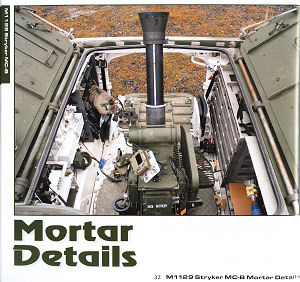
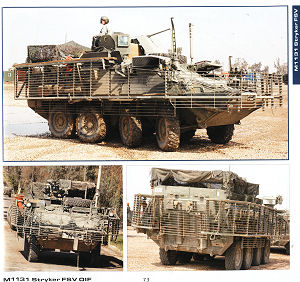
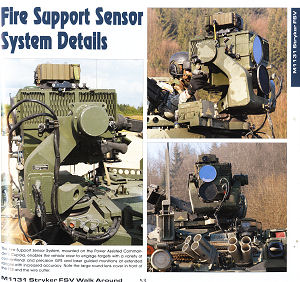
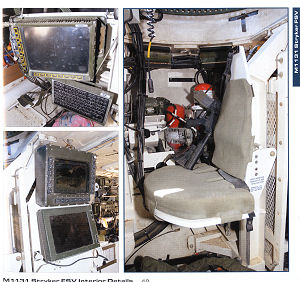
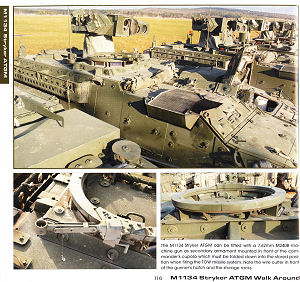
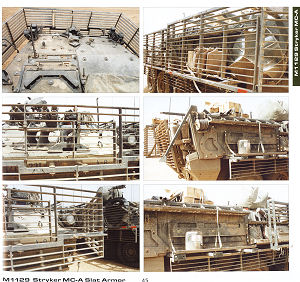
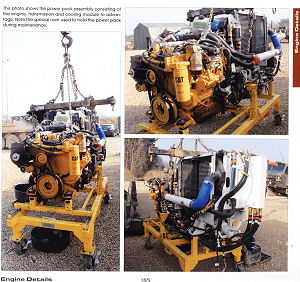
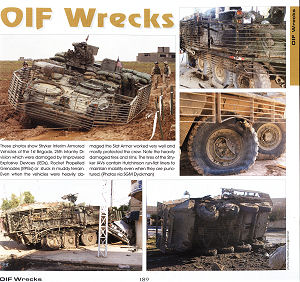
Thanks to František of Wings & Wheels Publications for the review book.

